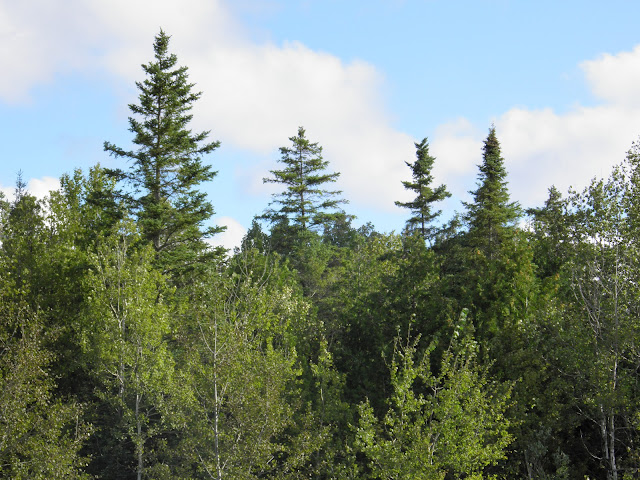In our travels across North America this week, we have been to central Mexico, southern California, Virginia, Michigan, Pennsylvania, and out in the middle of everywhere, western Nebraska. As such, we have seen a wide variety of landscapes and ecosystems, which while highlighting the diversity of the continent, also tends to disconnect various regions into seemingly different worlds. Today, therefore, we take a look at one of the common elements of a broad stretch of the continent, a great tree that can make places as different as the Alaskan panhandle and the Hudson River valley seem a little more connected. This wonderful tree is the White Spruce, Picea Glauca.
 |
| The three White Spruces are joined by a Balsam Fir on the right. Taken at Father Marquette National Memorial in Michigan. |
While it is quite the stately spruce when allowed to grow out, unencumbered by a tight canopy, our good friend tends to get the short end of the stick in terms of landscaping options. When in any cool winter area, one needs but look around and nearly everywhere in sight will be planted the Colorado Blue Spruce (Picea Pungens), strongly favored for its archetypal "Christmas tree" form and showy blue, silver, and green foliage. A nice tree, to be sure, but one that is remarkably confined in natural range, occurring mainly in the Rocky Mountains of Colorado and Utah. Perhaps this adds to the prestige of including the tree in domestic landscaping; it adds a rugged western mountain touch to even the most mundane of parking lots. For all its beauty and supposed rugged image, however, the Blue Spruce looks remarkably ordered even in the wild and during stages of maturity.
 |
| A Blue Spruce hiding among the Aspen at the right, taken along Utah 12 north of Boulder. |
White Spruce, in contrast, is a tree that does not herald the mountain wilds of the Colorado Rockies, but rather a sentinel of the great expanse of the north. This is a tree not nearly as ordered as a Blue Spruce, but a defiant, scraggly looking pillar of cones and needles that sends out strong looking straight branches, even after it has endured an extremely dense snow pack for much of the year. It bids welcome to those who come to its land from the south, with a distinct northern look, and outlasts most other trees where it finally succumbs to the intense Arctic cold at the treeline far to the north.
+-+USGS+Forest+Service+Native+Range+Map.jpg) |
| Courtesy USGS |
White Spruce can be found in parts of South Dakota, Wyoming, and Montana, detached from the main parts of their range, isolated thousands of years ago as the great glaciers retreated and the Great Plains dried up and warmed. Nevertheless, the sentinel of the North extends further than all but the hardiest junipers into the meeting place of prairie and boreal woods. It surrenders to the dense, sun-blocking canopies of the eastern forests in Michigan, southern Ontario, and New York, perhaps because its survival is guaranteed in the rest of the remaining forests to the north of these places. It grows near the Pacific Ocean far to the west, where it mingles with the Douglas Fir (Pseudotsuga Menziesii), another impressive tree which grows as far north to south as this one does east to west. It bridges gaps between grasslands, mountains, tundra, taiga, and coasts, and like the Black Spruce (Picea Mariana) is a true indicator species of the common northern crown of North America; it once guided explorers, voyageurs, and native peoples to and from northern lands.

No comments:
Post a Comment